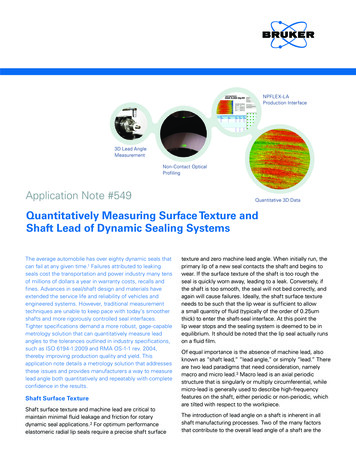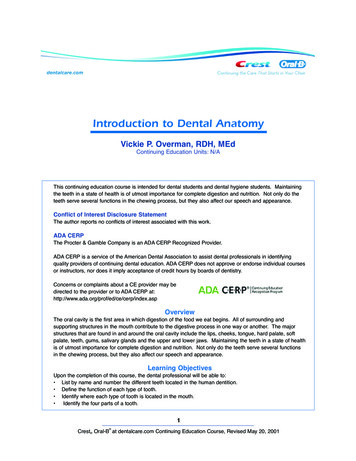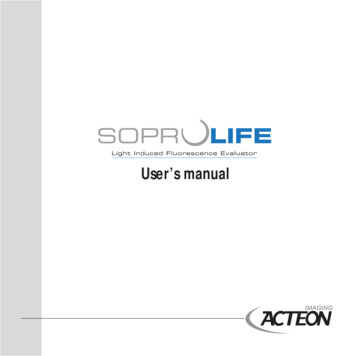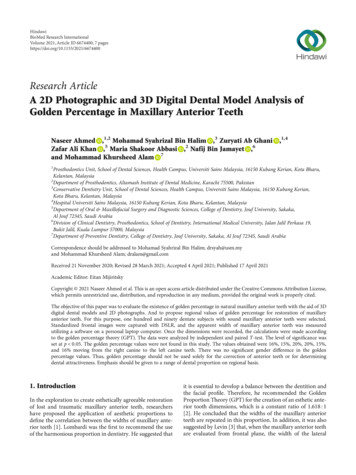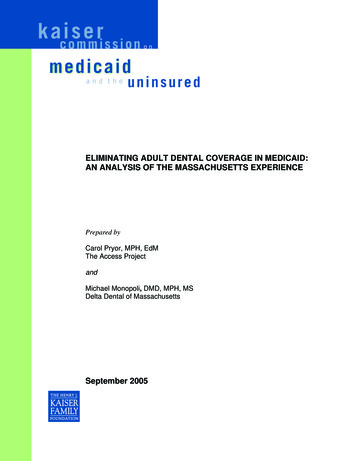
Transcription
DENTAL MICROWEAR TEXTURE ANALYSIS OF DENTIN: CAN MAMMALIANDIETS BE INFERRED WITHOUT ENAMEL?ByRyan James HauptThesisSubmitted to the Faculty of theGraduate School of Vanderbilt Universityin partial fulfillment of the requirementsfor the degree ofMASTER OF SCIENCEinEarth and Environmental SciencesDecember, 2012Nashville, TennesseeApproved:Professor Larisa DeSantisProfessor Jonathan Gilligan
To my parents, for ensuring that I never had any reason to quitii
ACKNOWLEDGEMENTSNone of this would have been possible without the guidance and assistance of myadvisor, Larisa DeSantis. Larisa’s drive and determination pushed me to produce mybest work at all times. I will continue forward in science with her imprint of unbridleddetermination, stalwart honesty, and boundless enthusiasm as my most cherishedprinciples.I also benefitted greatly from the advice and guidance of my committee members,Guilherme Gualda and Molly Miller, and my reader Jonathan Gilligan. Additionally, mycollaborators Jeremy Green and Peter Ungar, who have been directly involved in thecomposition of this work. Their knowledge, experience, and generosity made it so Ialways had the resources I needed to achieve my goals.I also wish to thank my lab mates, Lindsey Yann and Shelly Donohue. Their helpand camaraderie over the past two years have been invaluable in all aspects of completinga Masters. The trips we’ve taken and the experiences we share will make me smile foryears to come, and I look forward to us all continuing our scientific endeavors as friendsand collaborators.I am also grateful to the undergraduate students, Lucas Loffredo and NatalieJordan, who came to FLMNH to assist Lindsey and I in collecting the specimens neededto complete this work.This work relied gratefully on the help of the following museum collectionmanagers Richard Hulbert (FLMNH), Candace McCaffery (FLMNH), Eileen Westwigiii
(AMNH), Judith Chupasko (MCZ), and Nancy McCartney (UABR) for access to themuseums that provided samples. And a special thanks to Melissa Zolnierz forcoordinating access to the Paleoanthropology Lab at the University of Arkansas.Completing this work would have been monumentally more difficult without thelove and support of my family and friends, especially my parents, sister, and girlfriend,all of whom have been forced to sit through overly-long explanations about the lives ofsloths as well as the trials and tribulations of grad school. Thank you for always havingan open ear.Funding for this work was provided the Department of Earth and EnvironmentalSciences at Vanderbilt University and a student research grant from the GeologicalSociety of America.iv
TABLE OF CONTENTSPageDEDICATION iiACKNOWLEDGEMENTS . iiiLIST OF TABLES . . . viiLIST OF FIGURES .viiiLIST OF ABBREVIATIONS .ixChapterI.INTRODUCTION . . .1Extant xenarthran natural and ecology. 2Paleoecology of extinct xenarthrans from Florida . .5Previous work on xenarthran microwear .11DMTA Characteristics .14Goals and Objectives . .16II.MATERIALS AND METHODS .17Acquisition and preparation of specimens .17Scanning .18Data processing and statistical analysis .24III.RESULTS .26Florida panther dentin versus enamel 26Extant xenarthrans .28Extinct xenarthrans 32v
IV.DISCUSSION 37Differences between enamel and dentin 37Extant xenarthrans .38Extinct xenarthrans 41Conclusions and applications .45REFERENCES .47vi
LIST OF TABLESTablePage1.List of Florida panther (Puma concolor coryi) samples from the mammalogycollection at FLMNH . .192.Sample list of extant xenarthrans, all teeth refer to lower molariforms, loose teethare identified as ‘m’ for molariform, and asterisks indicate that the scan was of anactual tooth . . . . . .213.Sample list for extinct xenarthrans. Tooth identifications are from the FLMNHdatabase. . . . .224.Descriptive and comparative statistics of Florida panther samples (n 14) notingmeans, standard deviations (SD), and P-values for normality of both enamel anddentin data. Samples were compared by looking at the mean absolute deviationbetween characters and using both a Wilcoxon signed-rank test (non-parametric)and a two-sample paired Student’s T-test (parametric), when normally distributedaccording to a Shapiro-Wilk test. . .275.Descriptive statistics of extant xenarthran samples including mean, standarddeviation (SD), median, and P-values for normality. Normality P-values werecalculated using a Shapiro-Wilk test. . . 306.A summary of P-value results of Kruskal-Wallis and Brown-Forsythe testsbetween extant xenarthran taxa. Sloths (B. variegatus and C. hoffmanni) werecompared to D. novemcinctus individually, as well as grouped together (suborderFolivora) and compared using a Mann-Whitney U test .317.Descriptive statistics for all extinct xenarthrans sampled . 348.Comparative statistics between extant and extinct xenarthrans . .36vii
LIST OF FIGURESFigurePage1.Buccal and occlusal views of the dentition of xenarthran species examined in thisstudy, including: A) Dasypus novemcinctus B) Choloepus hoffmanni, C)Bradypus variegatus. All views have the anterior direction to the left. Not toscale. . . . . .32.Simplified cladogram showing currently accepted relationships between taxa inthis study. Extinct genera designated with †. Use of Pilosa rather than Folivoradone to prevent seeming exclusion of myrmecophagous xenarthrans (based onEngelmann 1985, Patterson and Pascual 1968, Webb 1985). . 83.Idealized reconstructions of DMTA surface characteristics showing: a) highcomplexity, b) high anisotropy, c) low heterogeneity, d) high heterogeneity(modified from Scott et al. 2006). . .154.Buccal view of a mandibular m1 carnassial from P. concolor (A, UF 31759)including representative 3-D photosimulations of microwear surfaces of enamel(B) and dentin (C) from the same specimen (UF30391). The black and whiterectangles (A) are representations 5x greater in magnitude than the actualscanned area of dentin and enamel, respectively . . .205.3D simulation of surface texture scans. A) Dasypus novemcinctus (UF4934) B) Choloepus hoffmanni (UF25984), and, C) Bradypus variegatus(UF14761) .296.Anisotropy (epLsar) versus complexity (Asfc) of extant xenarthran samples .327.epLsar vs. Asfc for extinct xenarthrans, showing overlap with extant specimens.(H) indicates a taxa from Haile 7G, (I) indicates taxa from Inglis 1A, and (L)indicates taxa from Leisey 1A. . .448.Occlusal and Buccal view of Holmesina jaw with teeth (based on Edmund1985) .45viii
LIST OF ABBREVIATIONSAsfc – Area-scale fractal complexityepLsar – AnisotropySmc – Scale of maximal complexityTfv – Textural fill volumeHAsfc – HeterogeneityDMTA – Dental microwear texture analysisSSFA – Scale-sensitive fractal analysisREE – Rare earth elementsSEM – Scanning electron microscopeFLMNH – Florida Museum of Natural HistoryAMNH – American Museum of Natural HistoryNMNH – National Museum of Natural HistoryMCZ – Museum of Comparative ZoologyUABRC – University of Arkansas Biological Research CenterC. hoffmanni – Hoffman’s two-toed slothB. variegatus – Brown-throated three-toed slothix
D. novemcinctus – Nine-banded or long-nosed armadilloE. eomigrans – Megatheriid giant ground slothH. floridanus – Giant armadillo-like pampathereM. leptostomus – Megalonychid ground slothP. harlani – Harlan’s ground slothP. concolor coryi – Florida panther, a subspecies of PumaANOVA – analysis of variancex
CHAPTER IINTRODUCTIONUnderstanding an animal’s dietary ecology is essential to clarifying their overallecology and is particularly critical in the face of climate change, where interactionsbetween an animal and their food might be disrupted by changes in temperature, range, orseasonality (Barnosky et al. 2003, Colwell et al. 2008, Sheldon et al. 2011). Therefore, itis important to determine if existing methods of dietary analysis can be applied tounderstudied groups of animals, such as xenarthrans (i.e., sloths, armadillos andanteaters; Vizcaíno and Loughry 2008). It is only by having a more complete picture of acommunity’s ecology that we can then attempt to predict how these communities mightrespond in the face of global climate change. Further, if the methods employed hereincan reliably record observed diets in extant taxa, then they can potentially be applied to adiverse array of extinct taxa (e.g., giant armadillo-like pampatheres, and ground sloths)which endured periods of dramatic glacial-interglacial climatic shifts (Hulbert 2001).Although tools such as dental microwear texture analysis (DMTA) of toothenamel can distinguish between different dietary niches in primates, carnivores,marsupials, and bovids (Prideaux et al. 2009, Schubert et al. 2010, Scott et al. 2006, Scott2012, Ungar et al. 2007), xenarthrans pose a unique challenge because their permanentteeth lack enamel. We have a reasonable understanding of how enamel is modified inresponse to food intake and diet (Baker et al. 1959, Teaford 1988b), the same is not trueof dentin. Does microwear of dentin reflect diet as it does for enamel? Here we address1
this question with a study of dentin microwear texture in teeth with exposed functionaldentin and enamel in the form of carnassials, as well by examining extant and extinctxenarthrans with known differences in diet.Extant xenarthran natural history and ecologyThe Magnorder Xenarthra is a group of basal placental mammals endemic toSouth America (Archibald 2003, Vizcaíno and Loughry 2008). Some xenarthrans, likeanteaters, lack teeth entirely (hence the previous polyphyletic name for the clade“Edentata,” meaning tooth-less), whereas all living toothed xenarthrans (i.e., sloths andarmadillos), lack enamel on their permanent (Vizcaíno 2009). To compensate for this,toothed xenarthrans have a number of modifications to the more common mammaliandental plan including ever-growing, or hypselodont, teeth (Vizcaíno 2009). Xenarthranteeth are typically composed of two layers of dentin, sometimes with a coating ofcementum of varying degrees of thickness, an inner softer layer and a harder outer dentinlayer (Fig. 1; Ferigolo 1985, Vizcaíno 2009). The inner dentin (sometimes referred to asorthodentine or vasodentine) is in some taxa similar in hardness to the orthodentine foundin other mammals (Ferigolo 1985, MacFadden et al. 2010). The outer dentin (sometimescalled osteodentine or hardened/hypermineralized orthodentine) is a more mineralizedform of dentin than found in typical mammalian teeth but which is still significantlysofter than enamel with an average Mohs’ hardness of 3.8 in contrast to 5.7 (Ferigolo1985, Kalthoff 2011, MacFadden et al. 2010). When examining xenarthrans in this study,2
we only assess the microwear texture of the outer layer of dentin, and to avoid confusionwill use the term outer dentin (in keeping with MacFadden et al. 2010).Figure 1: Buccal and occlusal views of the dentition of xenarthran species examined inthis study, including: A) Dasypus novemcinctus B) Choloepus hoffmanni, C) Bradypusvariegatus. All views have the anterior direction to the left. Not to scale.3
Both extant genera of tree sloths evidently evolved convergently from extinctground-dwelling ancestors (Gaudin 2004, Webb 1985). The three-toed sloth, Bradypusvariegatus, is exclusively folivorous with a preference towards young leaves of only afew tree families per individual and is thought to have a more constrained diet whencompared to members of the two-toed sloth genus Choloepus (Chiarello 2008, Urbaniand Bosque 2007). Other than one study of Costa Rican agroforest and other artificialhabitats (Vaughan et al. 2007), Choloepus lacks dietary data for wild populations but isthought to be primarily folivorous; however, it will consume branches, fruit, flowers, andeven eggs when available (Chiarello 2008). The nine-banded armadillo, Dasypusnovemcinctus, in contrast, is a burrowing terrestrial opportunistic insectivore/omnivorewith a preference for ground-dwelling insects, small vertebrates and vegetal/fungalmatter with specific diets varying by region and season (Breece and Dusi 1985, daSilveira Anacleto 2007, Redford 1985, Sikes et al. 1990). The armadillo lifestyle andtendency to eat food items found underground indicates that this xenarthran consumes alarge amount of dirt and grit (Breece and Dusi 1985), potentially influencing microwearpatterns on their teeth.While modern xenarthrans are elusive and less well understood than many othereutherians, even less is known about the dietary ecology of their fossil relatives (Vizcaínoand Loughry 2008a). Although morphological studies have shed light on xenarthranpaleoecology, equivocal dietary interpretations leave large gaps in our understandings ofthe histories of New World communities containing these animals. Ground sloths wereamong first immigrants to North American during the Great Biotic Interchange, evenpredating the connection of the two continents via the Panamanian land bridge (Marshall4
1988, Stehli and Webb 1985, Webb 2006). However, as many species of extinctxenarthrans have no extant analogs (Vizcaíno and Loughry 2008a), understanding theirpaleobiology and paleoecology is challenging.Paleoecology of extinct xenarthrans from FloridaAs mentioned above, the paleoecology of extinct xenarthrans is poorlyunderstood. However, there are various lines of evidence for which basic conclusionsabout their diet and lifestyle can be drawn including: morphological analysis, scatologicalanalysis, and environmental analysis.Previous studies of the jaw biomechanics and morphology of Cingulata, the orderwithin xenarthrans containing armadillos, pampatheres and glyptodonts, found thatprimitive xenarthrans were likely insectivores (Vizcaíno et al. 2004). However,adaptations including some novel mastication mechanisms with no modern analogues,allowed the group to diversify into herbivory, carnivory, with some examples of highlyspecialized myrmecophagy, and omnivory (Vizcaíno et al. 2004). A later study wasconducted looking only at glyptodonts, and in comparing ratios of relative muzzle width,hypsodonty index, and dental occlusal surface was able to show that smaller more basalglyptodonts were selective herbivores, whereas larger glyptodonts became moregeneralist feeders (except in the case of the Pleistocene Glyptodon, which appears to haveshifted back to a more specialized feeding mode; Vizcaíno et al. 2011). Theecomorphology of ground sloths (Tardigrada) has also been examined via similartechniques (Bargo and Vizcaíno 2008). These data instead suggest niche-partitioning inground sloths based on muzzle-width, with the wider-mouthed taxa as bulk-feeders and5
narrow-mouthed taxa as more mixed or selective in their forage (Bargo and Vizcaíno2008).Researchers have also begun exploring methods of direct analysis such as stableisotope geochemistry (Czerwonogora et al. 2011, MacFadden et al. 2010, Pérez-Crespo etal. 2011, Ruez 2005) and dental microwear (Green 2009a, Green 2009b, Green and Resar2012, Oliveira 2001), but issues with both these methods remain (See “Previous work onxenarthran microwear” pg. 11). Specifically, geochemical studies have been limitedbecause permanent xenarthran teeth contain only dentin, which has a higher organiccontent than enamel and is more prone to taphonomic and diagenetic alteration (Green2009a, Kalthoff 2011, MacFadden et al. 2010, Vizcaíno 2009, Wang and Cerling 1994).As researchers have shown that rare earth element (REE) analysis can be used as a proxyfor testing the amount of chemical alteration to dental material (MacFadden et al. 2010),it is therefore possible that xenarthran teeth may yield biologically meaningful stableisotope values. However, stable isotope geochemistry of teeth provides a longer-termdietary signal representing the average diet at the time of tissue formation and the exactfractionation rates of xenarthrans have yet to be determined (MacFadden et al. 2010), andas such, additional methods of paleoecological investigation should be explored asefficacious alternatives.In addition to attempting to develop an extant dental microwear texture baseline,we also want to examine extinct taxa to clarify their dietary ecology by comparing themto sympatric extinct taxa and extant relatives. While the hardness of teeth between extantand extinct groups was not shown to be statistically significantly different by MacFaddenet al. (2010), it is also not known how subtle differences in hardness might affect6
preservation of microwear. There may be some as yet unknown threshold of hardnesswhich limits the use of microwear, and such distinction may only be found by examiningtaxa with dental materials of varying hardness.This work focuses on four extinct xenarthran species found at three separate fossilsites in Florida. The sites represent both glacial and interglacial time periods, whichgives researchers the opportunity to explore how behavior might change depending ondifferent environments. Further, the presence or absence of a given species at a given sitemight shed light on preferred environments or overall adaptability through changingclimates.The three sites sampled for this study are Haile 7G, Inglis 1A, and Leisey 1A.Haile 7G is interpreted as a sinkhole which formed within a dense forest, based on theabundance of forest indicator taxa such as tapirs (DeSantis and MacFadden 2007, Hulbertet al. 2006). This interpretation has been confirmed with stable isotope geochemistry,which showed that herbivores found at the locality were consuming primarily C3 plants,indicating a forested environment (DeSantis and MacFadden 2008). Inglis 1A is a glacialfossil site, determined based on geological evidence and further supported bygeochemical studies, and is also dominated by browsing taxa (DeSantis et al. 2009,Morgan and Hulbert 1995). Contrariwise, Leisey 1A is an interglacial site (similarlybased on geologic evidence and further supported by isotopic data) and it has a moreeven distribution of browsers, mixed feeders, and grazers making up the mammalianfauna (DeSantis et al, 2009; Morgan and Hulbert 1995).Thus, we examined three ground sloths from three separate evolutionary lineagesof the suborder Folivora (of the order Pilosa, which includes both sloths and anteaters):7
Megatheriidae, Megalonychidae, and Mylodontidae. We also examined the pampathere(i.e. Pampatheriidae) Holmesina floridanus. Relationships between the taxa in this studyare outlined in a simplified cladogram (Fig. 2). The cingulates Dasypus novemcinctusand Holmesina floridanus are more closely related to each other than any of thefolivorans (i.e. sloths). Amongst the folivorans, Paramylodon is a member of the entirelyextinct lineage of mylodontid sloths, Eremotherium and Bradypus are both megatheriidsloths, and Megalonyx and Choloepus are both megalonychid sloths. Further, weattempted to pick specimens that overlapped with each other in some or all of thelocalities examined to control for available vegetation and potentially highlight dietarydifferences between glacial and interglacial habitats.Figure 2: Simplified cladogram showing currently accepted relationships between taxa inthis study. Extinct genera designated with †. Use of Pilosa
dental plan including ever-growing, or hypselodont, teeth (Vizcaíno 2009). Xenarthran teeth are typically composed of two layers of dentin, sometimes with a coating of cementum of varying degrees of thickness, an inner softer layer and a harder outer dentin layer (Fig. 1; Ferigolo 1985, V

